January 2009 LIP of the Month
Reconstructing Ancient Continents Using the Large Igneous Province Record: Implications For Mineral, Hydrocarbon, and Earth Systems
Richard E. Ernst
(Ernst Geosciences, Ottawa, Canada; Richard.Ernst@ErnstGeosciences.com)
Wouter Bleeker
(Geological Survey of Canada, Ottawa, Canada; wbleeker@nrcan.gc.ca)
Michael A. Hamilton
(University of Toronto, Toronto, Canada; mahamilton@geology.utoronto.ca)
Ulf Söderlund
(Lund University, Lund, Sweden; Ulf.Soderlund@geol.lu.se)
modified after Ernst et al. (2008)
Summary
Paleocontinental reconstructions are critical to providing a tectonic context for major ore deposits and their metallogenic districts, the tracing of belts between blocks, and the identification and ranking of new prospective regions for mineral deposits of a wide variety of types. They are equally important to understanding the full context of sedimentary basins, their evolution, and their hydrocarbon reserves and potential. More broadly, robust paleocontinental reconstructions and the recognition of supercontinents through time are essential for inter-block tracing of all geological and, structural features of the lithosphere, including their deep mantle roots, and for providing a paleogeographic framework for assessing Earth’s geodynamic evolution and climatic variations through time.
Unfortunately, the state of understanding of pre-Pangaea reconstructions and their specific paleogeography is tentative at best. There is good evidence, based on the episodic nature of orogenic belts, that there have been several Precambrian supercontinents, specifically, in the late Archean (e.g., Kenorland, or perhaps three supercratons, Superia, Sclavia, Vaalbara), the late Paleoproterozoic (supercontinent Nuna, also referred to as Columbia), and the Neoproterozoic (Rodinia). Beyond these general concepts, the exact reconstructions are poorly constrained. The high-quality information content of the LIP record (precise ages, trends, precise piercing points, paleomagnetic information; see Fig. 1 for LIP record) can resolve these issues unambiguously. With a global team of collaborators, we have organized an Industry-Government-University consortium for a 5-year project to constrain paleocontinental reconstructions back to ca. 2.6 Ga using the LIP record. This is an ambitious but realistic goal given recent breakthroughs in correlation techniques using LIPs.
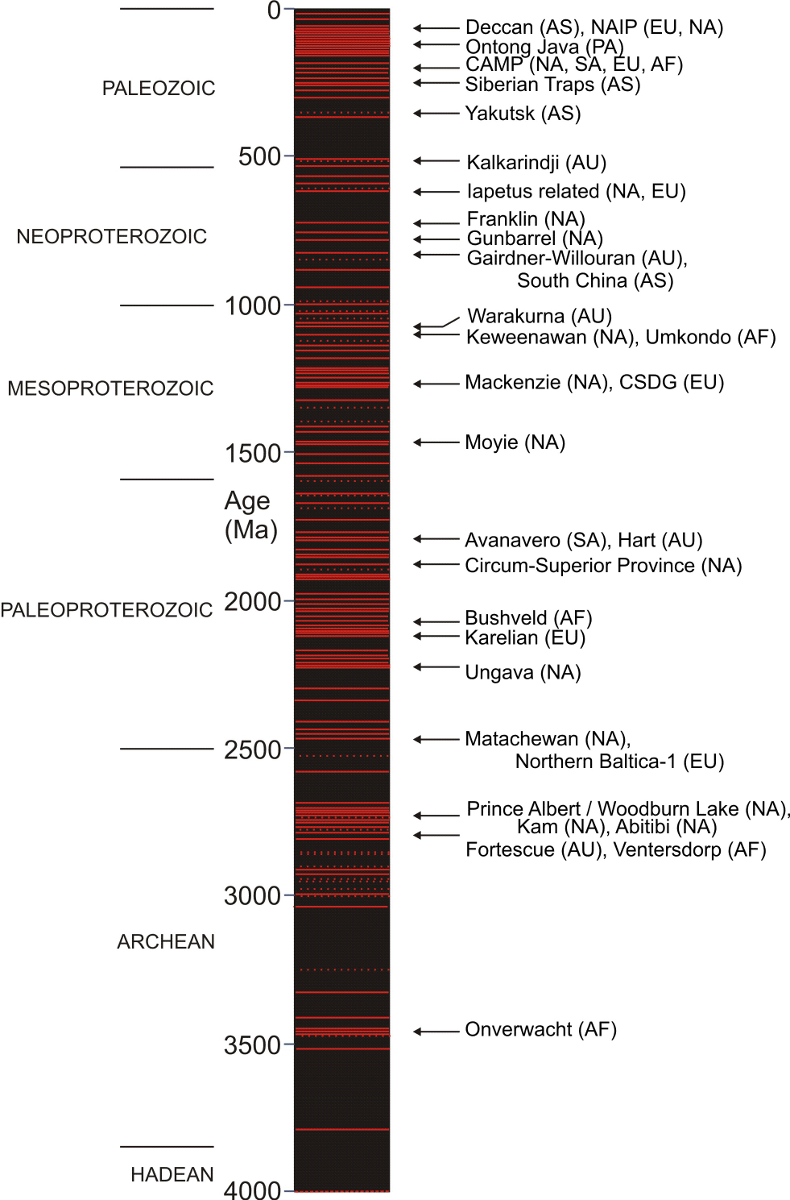
Figure 1: Global barcode of LIPs through time. Abbreviations: NA, North America; SA, South America; EU, Europe; AF, Africa; AS, Asia; Au, Australia; PA, Pacific Ocean. Modified after Ernst et al. (2005).
Background
Large Igneous Provinces (LIPs)
LIPs and their dyke swarms (www.largeigneousprovinces.org), typically preceding and accompanying the breakup of continents, can now be dated routinely with both high precision and accuracy using U-Pb baddeleyite and zircon methods. Continental breakup leaves remnants of sharply-timed LIP events on conjugate margins and their cratonic hinterlands. Precise dating multiple LIP events produces, in effect, a high-fidelity ‘barcode’ for a craton or terrane that can be compared to that of other cratons or terranes (e.g., Fig. 2). Originally contiguous crustal fragments will share essential parts of their barcodes. Any precise barcode match beyond just a single event almost certainly indicates an original ‘nearest neighbour’ relationship (Bleeker and Ernst 2006; Bleeker 2008; see also May 2006 LIP of the Month).
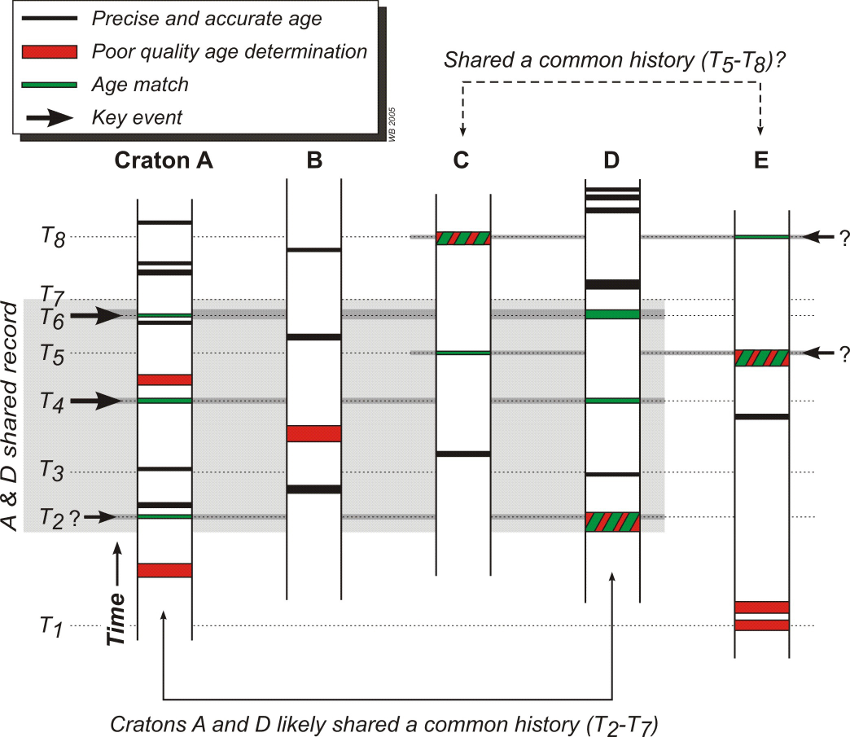
Figure 2: Hypothetical ‘barcodes’ for five cratons. Individual ‘bars’ are the age range of short-lived magmatic events on vertical timelines. Partially matching barcodes (e.g. between cratons A and D) from time T4 to T7, and possibly from as early as T2) are a strong indication that the two cratons were contiguous (i.e. ‘nearest neighbours’) in an ancestral supercraton. Cratons C and E are unrelated to A and D, but may have shared a common history as part of another supercraton; more precise age data would be required to test this correlation. Craton B, with no matches, must represent a distant, if not unrelated, fragment of crust (after Bleeker and Ernst 2006).
Not only do short-lived magmatic LIP events contain precise temporal information, they also contain structural and paleomagnetic information, and much more. Dyke swarms intersecting craton margins at high angle and extending far into cratonic hinterlands provide very precise piercing points that are relatively insensitive to collision and uplift.
Critical progress in all these fields has quickly made this integrated method using LIPs (precise barcodes, precise piercing points, trends, key paleomagnetic poles, etc.; Figs. 3, 4) into a powerful and robust correlation tool (Bleeker and Ernst 2006).
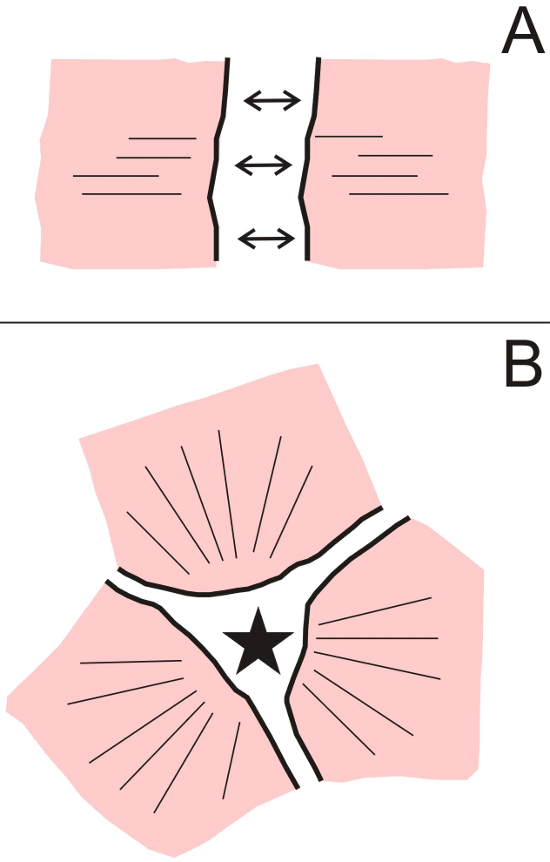
Figure 3: Use of giant dyke swarms as piercing points for continental reconstruction. A) Giant linear swarms. B) Giant radiating dyke swarms. After Ernst and Buchan (2004).
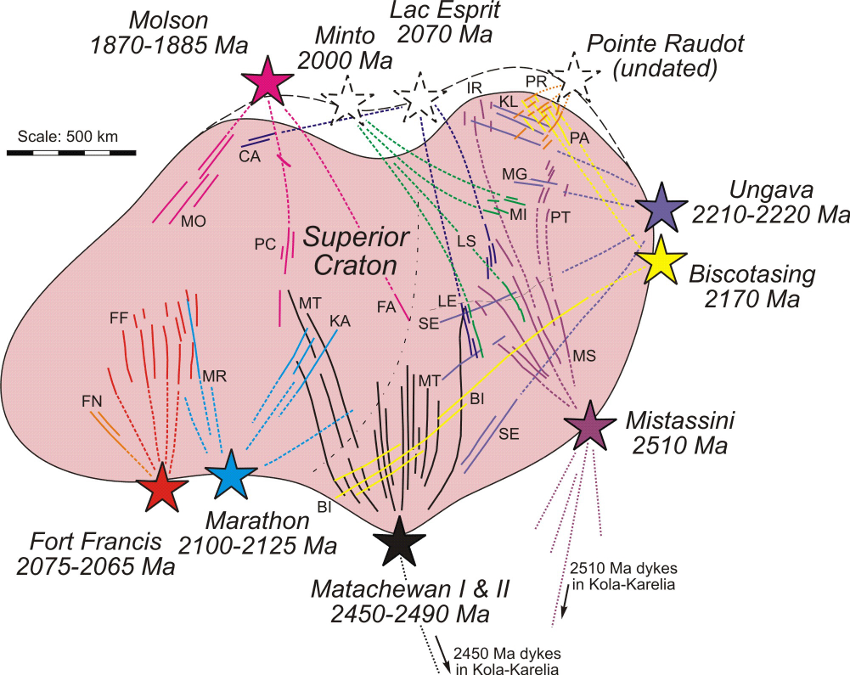
Figure 4: Proterozoic radiating dyke swarms and their inferred plume centres associated with the breakup of the Superior craton out of its ancestral landmass, supercraton Superia. Dyke swarms are labeled as follows: BI = Biscotasing, CA = Cauchon, FA= Fort Albany, FF = Fort Frances, FN = Franklin (of Fort Frances event), IR = Irsuaq, KA = Kapuskasing, KL = Klotz, LE = Lac Esprit, LS =Lac Shpogan, MI = Minto, MG = Maguire, MO = Molson, MR = Marathon, MS = Mistassini, MT= Matachewan, PA= Payne River, PC = Pickle Crow, PR = Point Raudot, PT = Ptarmigan SE = Senneterre. Dash-dotted arc locates Kapuskasing Zone along which the east and west halves of the Superior craton rotated in the late Paleoproterozoic. After Ernst and Bleeker (2009).
Examples of Paleocontinental Reconstruction Questions Being Solved Using The LIP Record:
The pattern of the opening of the Labrador Sea is constrained by pre-breakup dyke swarms of the same age on both the Greenland and Canadian sides. Such dyke swarms provide precise piercing points (Fig. 5) suggesting a fit that can be further strengthened by paleomagnetic and geochemical comparisons of the swarms (Buchan et al., 1996).
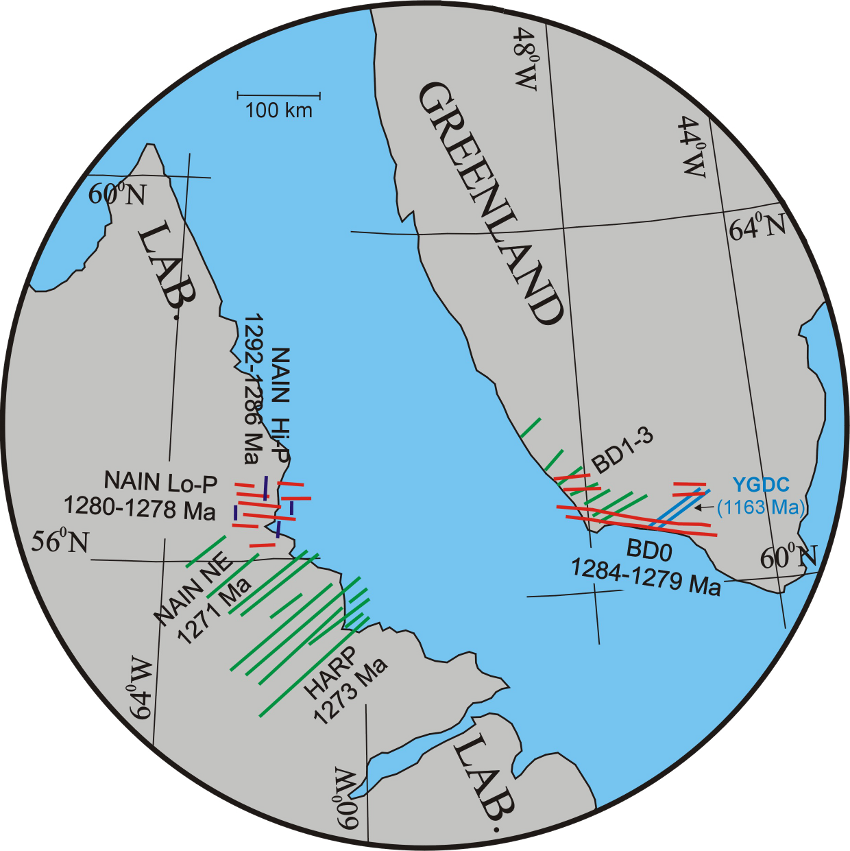
Figure 5: Dyke swarms as piercing points in the re-construction of Greenland and Labrador, Canada. Modified after Buchan et al. (1996). Reconstruction after Roest and Srivastava, 1989)
A major stage of development of the Arctic ocean can be linked to the initiation of the 130-90 Ma HALIP (High Arctic Large Igneous Province) affecting northern Canada, northern Greenland, Svalbard and Franz Josef Land (Maher 2001; Buchan and Ernst 2006; Drachev and Saunders 2006). Given the hydrocarbon potential of the Arctic, the detailed history of various margins, as well as the location of an interpreted mantle plume (associated with HALIP), has implications for hydrocarbon potential and maturation (and over maturation).
The 723 Ma Franklin LIP event of northern Canada (extending over 2 million km2) can now be linked with magmatism in southern Siberia because of a single new, preliminary, U-Pb age (725+/-8 Ma; dated by M. Hamilton, sample collected by Alexay Lygin and supplied by BHP Billiton) on the Dovyren layered intrusion of the Lake Baikal region. This critical age match, in addition to several older LIP barcode matches, confirms that the southern Siberian craton was adjacent to northern Canada at 725 Ma and perhaps back to ca. 1800 Ma, the time of final amalgamation of supercontinent Nuna. Integration of Franklin magmatism across Arctic Canada and equivalent magmatism in Siberia into a single LIP will permit a system-scale analysis of the plumbing system of this giant LIP and assist in the targeting of associated ore deposits.
The ca. 1590 Ma Olympic Dam deposit and associated Gawler Range volcanics of the Gawler craton can be linked with northwest Laurentia on the basis of an age match with the coeval Wernecke Breccias (Thorkelson et al., 2001), and with the more recently dated Western Channel Diabase (WCD; Hamilton and Buchan 2007). The precise dates on WCD and resulting paleomagnetic comparison with the Gawler Range volcanics represent evidence for a Gawler – northwest Laurentia link at this time.
The ca. 2058 Ma Bushveld intrusion is linked with a number of other smaller coeval layered intrusions, sills, volcanics and a carbonatite intrusion (Phalaborwa) into a single LIP that is widespread throughout the Kaapvaal craton. The mutual absence of ca. 2058 Ma Bushveld magmatism in the adjacent Zimbabwe craton, and of 2575 Ma Great Dyke magmatism from the Kaapvaal craton, requires that the Zimbabwe and Kaapvaal cratons did not dock until after Bushveld time (e.g. Bleeker 2003). This insight from the LIP record alone cuts through the complicated structural analysis of the intervening Limpopo belt which has failed to yield a clear consensus regarding timing of collision.
The LIP record has been used to suggest a Paleoproterozoic reconstruction (>2500 Ma to about 2100 Ma) of Karelia-Kola, Hearne and Wyoming cratons against the southern margin of the Superior craton (Fig. 6; e.g., see Heaman 1997; Bleeker 2004; Bleeker and Ernst 2006). A resulting unique fit juxtaposes the 2500 Ma Mistassini and 2450-2480 Ma Matachewan-East Bull Lake events of the Superior craton against the Baltic Large Igneous Province (BLIP) of Karelia-Kola into a common LIP, allowing this magmatism (and its metallogeny) to be studied at a system-wide scale (e.g. Ernst 2007). As specifically anticipated by the reconstruction of Bleeker and Ernst (2006), ca. 2505 Ma dykes have now also been identified in Karelia (Bleeker et al. 2008).
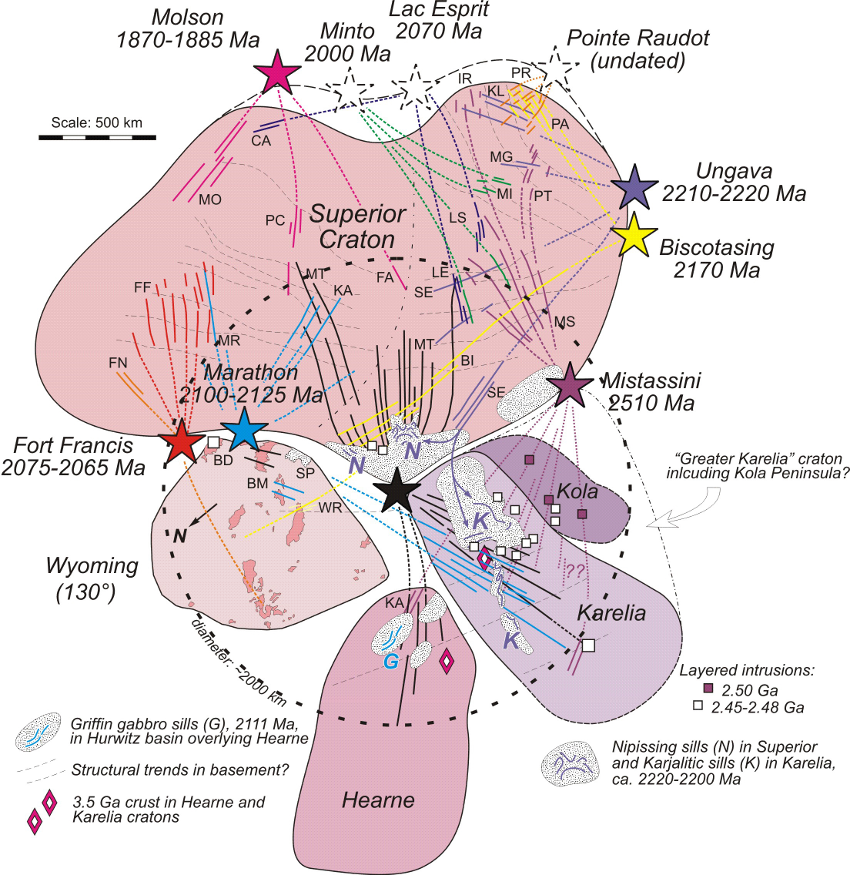
Figure 6: Neoarchean-Early Paleoproterozoic Reconstruction of Karelia, Kola, Hearne and Wyoming cratons against the southern margin of the Superior craton using the LIP barcode and dyke swarm piercing point methods. Labels for the Superior craton are as in Figure 4. Additional labels from the other blocks are as follows: BD = Blue Draw layered intrusion, BM= Bear Mountain dykes, SP = Snowy Pass gabbros, WR = Wind River dykes, After Ernst and Bleeker 2009, modified after Bleeker and Ernst (2006) to add the Wyoming craton. Circle of 1000 km radius drawn about the Matachewan plume centre to illustrate the potential size of the underlying plume.
The 2750-2700 Ma Abitibi greenstone belt of the Superior craton contains proven economic mineral wealth. Specifically, the E-W trending Abitibi belt has historically produced ~200 million ounces of Au, hosts some of the largest massive sulphide deposits in the world (Kidd Creek and Horne), and has significant base metal and Ni-Cu deposits. The Abitibi belt is truncated, however, on the eastern side by a probable Paleoproterozoic breakup margin which is now buried underneath the Grenville front. The block that has rifted away should contain the continuation of the Abitibi metallogenic belt, and may contain equally prosperous ore deposit riches. Is the missing block the Yilgarn, or perhaps the North China craton, Zimbabwe craton or another block? While the Superior barcode is well-populated, those of these other blocks remain poorly characterized.
Proposal
Constraining paleocontinental reconstructions back to ca. 2.6 Ga requires a dramatic expansion of precise dating of mafic units. It has been estimated that there are about 35 major Archean cratonic fragments (‘pieces of the puzzle’, see Bleeker 2003) and for each we ideally need about 10 events in order to define a unique barcode. So far, we have abundant geochronological information (and a relatively robust barcode) for Superior, Slave, Karelia, and parts of Australia, but for most blocks the data are poor or nonexistent. Once the precise barcode for each cratonic block or fragment has been defined, the global paleogeographic puzzle will quickly resolve itself with robust configurations for all major continental aggregations prior to Pangaea.
Fortunately, there is a vast reservoir of LIP units, especially giant dyke swarms, sill provinces and layered intrusions, available through time and on most cratonic blocks to be dated. To complete the barcodes for all major cratonic ‘pieces of the puzzle’ and achieve paleocontinental reconstructions back to ca. 2.6 Ga will require approximately 250 precise age determinations from targeted units around the world. A network of partners around the world will collaborate to obtain the necessary samples and direct them to the participating laboratories for dating. Ongoing information and updates regarding this project will be available on the Project website: www.supercontinent.org.
References
Bleeker, W. 2003. The late Archean record: a puzzle in ca. 35 pieces. Lithos, v.71, pp. 99-134.
Bleeker, W. 2004. Taking the pulse of planet Earth: a proposal for a new multi-disciplinary flagship project in Canadian solid Earth sciences: Geoscience Canada, v. 31, pp 179-190.
Bleeker, W., 2008. The pulse of the Earth. [abstract] 33rd International Geological Congress, Oslo 2008, 6-14 August (www.33igc.org).
Bleeker, W., Hamilton, R.E., Ernst, R.E., and Kulikov, V.S. 2008c. The search for Archean-Paleoproterozoic supercratons: New constraints on Superior-Karelia-Kola correlations within supercraton Superia, including the first ca. 2504 Ma (Mistassini) ages from Karelia [abstract] 33rd International Geological Congress, Oslo 2008, 6-14 August (www.33igc.org).
Bleeker W, and Ernst R. 2006. Short-lived mantle generated magmatic events and their dyke swarms: The key unlocking Earth's paleogeographic record back to 2.6 Ga. In Dyke Swarms - Time Markers of Crustal Evolution. Edited by E. Hanski, S. Mertanen, T. Rämö, and J. Vuollo. Taylor and Francis/Balkema, London, pp. 3-26.
Buchan, K.L., and Ernst, R. 2006. Giant dyke swarms and the reconstruction of the Canadian Arctic islands, Greenland, Svalbard and Franz Josef Land. In: Dyke Swarms: Time Markers of Crustal Evolution. Edited by E. Hanski, S. Mertanen, T. Rämö, anReconstructing Ancient Continents Using the Large Igneous Province Record: Implications For Mineral, Hydrocarbon, and Earth Systems, Richard E. Ernst, Wouter Bleeker, Michael A. Hamilton, Ulf Söderlundd J. Vuollo. Taylor and Francis/Balkema, London, pp. 27-48.
Buchan, K.L., Hodych, J.P., Roddick, J.C., Emslie, R.F., and Hamilton, M.A. 1996. Paleomagnetism and U-Pb geochronology of Mesoproterozoic dykes of Labrador and correlations with dykes of Southwest Greenland. Abstract for COPENA/ESCOOT/IBTA conference on Proterozoic Evolution in the North Atlantic realm, Goose Bay, Labrador, Canada, Program and Abstracts, p. 37.
Drachev, S., and Saunders, A. 2006. The Early Cretaceous Arctic LIP: its geodynamic setting and implications for Canada Basin opening. In: Scott, R.A., and Thurston D.K. (eds.) Proceedings of the Fourth International Conference on Arctic Margins, Dartmouth, Nova Scotia, Canada, September 30-October 3, 2003. OCS Study MMS 2006-003, U.S. Dept of the Interior, Anchorage, Alaska, pp. 216-223.
Ernst, R.E., and Buchan, K.L. 2004. Large Igneous Provinces (LIPs) in Canada and adjacent regions: 3 Ga to Present. Geoscience Canada, v. 31, no. 3, pp. 103-126.
Ernst, R.E. 2007. Large Igneous Provinces (LIPs) in Canada Through Time and Their Metallogenic Potential. In: Mineral Deposits of Canada: A Synthesis of Major Deposit-Types, District Metallogeny, the Evolution of Geological Provinces, and Exploration Methods, Edited by W.D. Goodfellow. Geological Association of Canada, Mineral Deposits Division, Special Publication 5, pp. 929-937.
Ernst, R.E., Buchan, K.L., and Campbell, I.H., 2005. Frontiers in Large Igneous Province research. Lithos, v. 79, pp. 271-297.
Ernst, R.E., Bleeker, W., Hamilton, M.A., Söderlund, U. 2008 Continental Reconstructions Back To 2.6 Ga Using The Large Igneous Province (LIP) Record, With Implications For Mineral Deposit Targeting And Hydrocarbon Resource Exploration [extended Abstract] In: P. Markwick, R. Livermore, M. Huber (conveners) Palaeogeography: The Spatial Context for Understanding the Earth System. Cambridge U.K., (August 10-13, 2008).
Ernst, R.E. and Bleeker, W. 2009. Large igneous provinces (LIPs), giant dyke swarms, and mantle plumes—Significance for assembly and breakup events within Canada from 2.6 Ga to present. In: Lithoprobe – Parameters, Processes and the Evolution of a Continent: Lithoprobe Synthesis Volume II. Earth Sciences Series, NRC Monograph Publishing Program, submitted.
Hamilton, M.A., and Buchan, K.L. 2007. Precise 1.59 Ga age for Western Channel Diabase, Wopmay orogen: implications for Laurentia APWP and reconstruction of Laurentia, Baltica and Gawler craton. Abstracts with Programs, Geological Society of America Annual Meeting, v. 39, pp. 285-286.
Heaman, L.M. 1997. Global mafic magmatism at 2.45 Ga: Remnants of an ancient large igneous province?: Geology, v. 25, no. 4, pp. 299-302.
Maher, H.D. 2001. Manifestation of the Cretaceous High Arctic Large Igneous Province in Svalbard. Journal of Geology, v. 109, pp. 91-104.
Thorkelson, D.J., Mortensen, J.K., Davidson, G.J., Creaser, R.A., Perez, W.A., and Abbott, J.G. 2001. Early Mesoproterozoic intrusive breccias in Yukon, Canada: the role of hydrothermal systems in reconstructions of North America and Australia. Precambrian Research, v.111, pp. 31-55.
